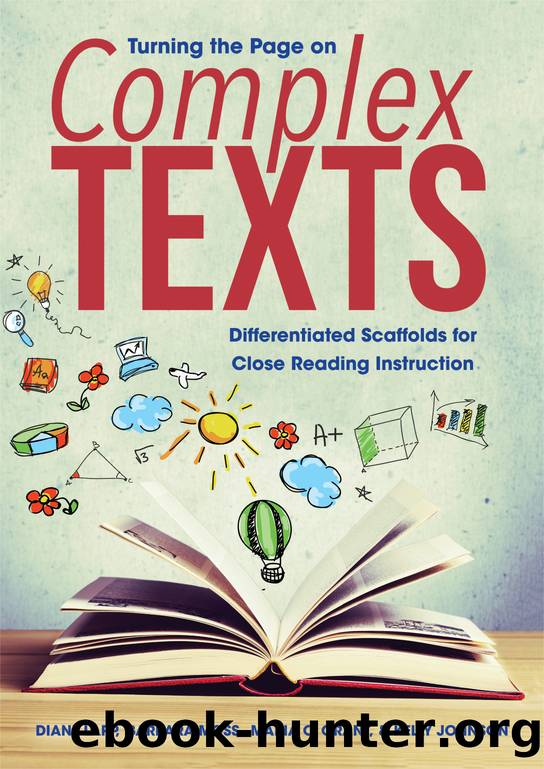Turning the Page on Complex Texts by Lapp Diane;Moss Barbara; & Barbara Moss & Maria C. Grant & Kelly Johnson

Author:Lapp, Diane;Moss, Barbara; & Barbara Moss & Maria C. Grant & Kelly Johnson
Language: eng
Format: epub
Publisher: Solution Tree
Published: 2016-08-15T00:00:00+00:00
3.Use the following table to detail what youâve learned about this character.
4.Because of the actions of ______________, my general understanding is that _______________ is _______________.
Figure 5.4: Graphic organizer for narrative text.
Visit go.SolutionTree.com/literacy for a free reproducible version of this figure.
The following example illustrates using graphic organizers to support small-group differentiated scaffolding for character analysis in a narrative text. When third-grade teacher Bonnie Franz chooses a section of the book Boundless Grace (Hoffman & Binch, 2000) as a close reading for her students, she knows that some of the ways in which the author develops Grace, the main character, will be tricky for her students. However, Mrs. Franz believes that through a rich discussion with both tablemates and peers in the whole class, students would understand Graceâs character traits. As the whole-class close reading is drawing to a close, three students need some differentiated scaffolds to help their meaning making. Before calling these students to her table, Mrs. Franz challenges the rest of the class to use multiple texts to get an even deeper understanding of the character Grace, saying, âYou know about Grace from reading this text, Boundless Grace, and from reading Amazing Grace last week. Make an interactive graphic organizer with your close reading partner to organize your thoughts about some of the similarities and differences you learned about Grace between the two books. Think about how your understanding of Grace deepened with Mary Hoffmanâs second book.â
While the students who comprehend the lesson create their graphic organizer and organize their thoughts across multiple texts, Mrs. Franz quietly taps three students on the shoulder and asks them to come with her so they can more deeply examine Graceâs character. She gathers the students discreetly because she does not want to interrupt the others, and she also does not want to call attention to this small group. Mrs. Franz presents the students with a graphic organizer (see figure 5.4), which is copied on large legal-sized paper. Together, students revisit parts of the text and organize their thoughts using the chart as a shared scaffold. Each student has a different colored pencil and fills in parts of the chart as a shared experience. Mrs. Franz gives a copy of selected passages to all three students. Through the following conversation, the students begin to make meaning and understand how Grace develops as a character.
Mrs. Franz says, âLetâs look at the illustrations and see what we learn about Grace by her physical features. Pay attention to what you see.â
âShe likes to talk on the phone; see here on page 18 she is talking on the phone,â replies Myra.
Calista asks, âWho is she talking to?â
Mrs. Franz answers, âOK, but look more closely. What clues does the author or illustrator give you to help you understand Grace as a person?â
âDo you mean how she looks in the face?â Manuel further questions.
Mrs. Franz says, âGreat detective work. Keep going, Manuel.â
Manuel says, âI donât think she looks very happy, even though on the page before she does look happy.
Download
This site does not store any files on its server. We only index and link to content provided by other sites. Please contact the content providers to delete copyright contents if any and email us, we'll remove relevant links or contents immediately.
The Art of Coaching Workbook by Elena Aguilar(50129)
Trainspotting by Irvine Welsh(21050)
Twilight of the Idols With the Antichrist and Ecce Homo by Friedrich Nietzsche(18312)
Fangirl by Rainbow Rowell(8807)
Periodization Training for Sports by Tudor Bompa(7936)
Change Your Questions, Change Your Life by Marilee Adams(7389)
This Is How You Lose Her by Junot Diaz(6463)
Asking the Right Questions: A Guide to Critical Thinking by M. Neil Browne & Stuart M. Keeley(5369)
Grit by Angela Duckworth(5303)
Red Sparrow by Jason Matthews(5204)
Paper Towns by Green John(4812)
Room 212 by Kate Stewart(4745)
Ken Follett - World without end by Ken Follett(4453)
The Sports Rules Book by Human Kinetics(4087)
Housekeeping by Marilynne Robinson(4075)
Double Down (Diary of a Wimpy Kid Book 11) by Jeff Kinney(3941)
Papillon (English) by Henri Charrière(3924)
The Motorcycle Diaries by Ernesto Che Guevara(3796)
Exercise Technique Manual for Resistance Training by National Strength & Conditioning Association(3791)
